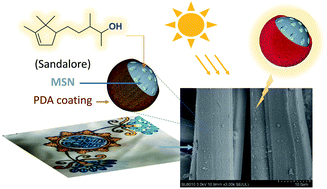A novel photothermo-responsive nanocarrier for the controlled release of low-volatile fragrances†
Abstract
We herein present a facile approach to create polydopamine (PDA) modified silica-based nanocarriers for use in the encapsulation and photothermally responsive release of the synthetic sandalwood odorant Sandalore (SA) as a low-volatile model fragrance. The method involves impregnating mesoporous silica nanoparticles with an ethanol solution of SA followed by surface functionalization via the in situ self-polymerization of dopamine under alkaline conditions. The resulted nanocomposites have high fragrance loading capacity with up to ∼85% by weight of SA relative to the silica matrix and are capable of effectively preserving the cargo in the dark or indoors. The aroma release was significantly accelerated upon illumination due to the photothermal heating effect of the PDA shell, which is proportional to the coating content and the irradiation intensity. Additionally, the emulated laundry tests showed that the composites exhibited a higher deposition efficiency on the fabric surface and better washing-resistance as compared to the control particles without PDA coating.



 Please wait while we load your content...
Please wait while we load your content...